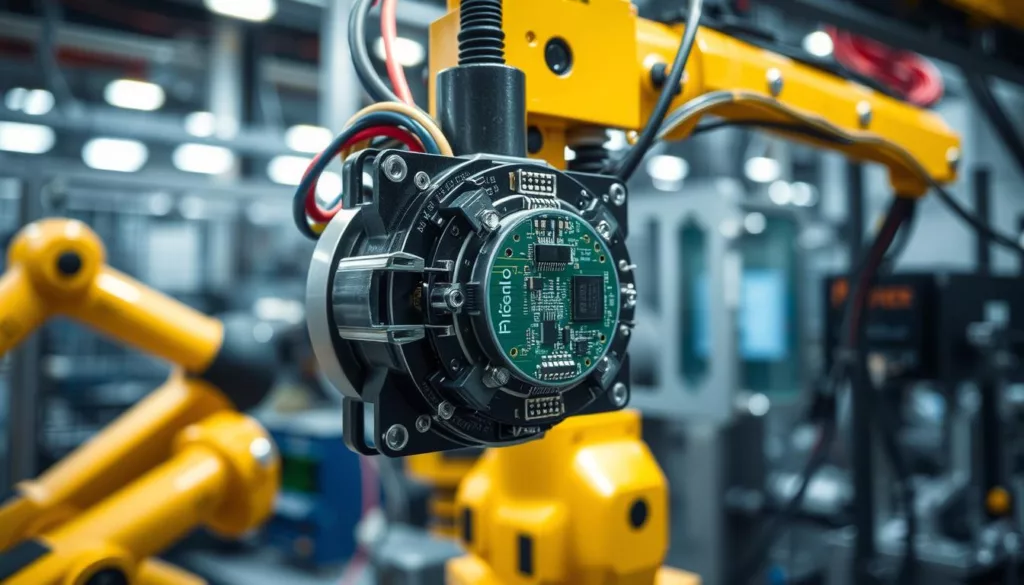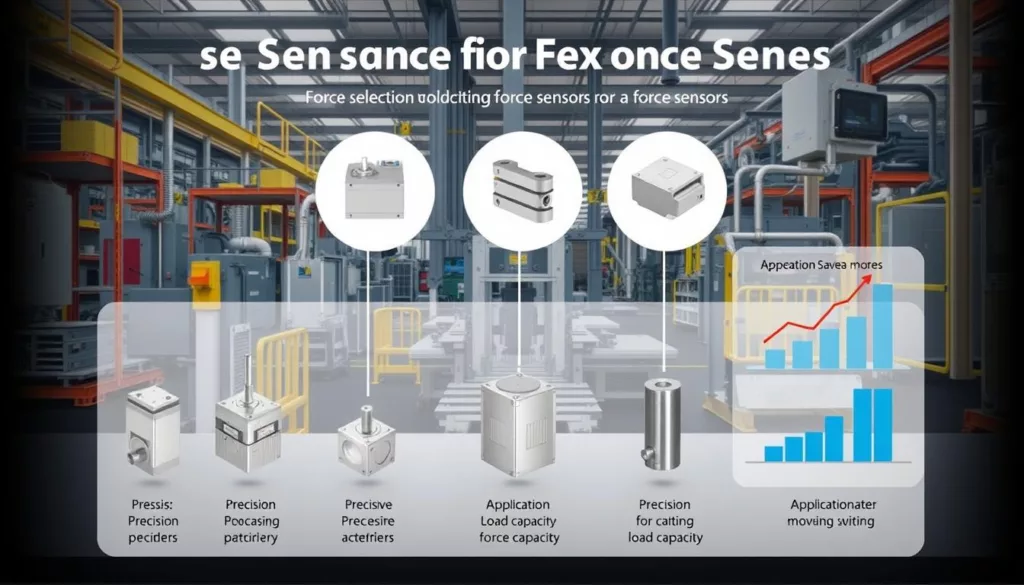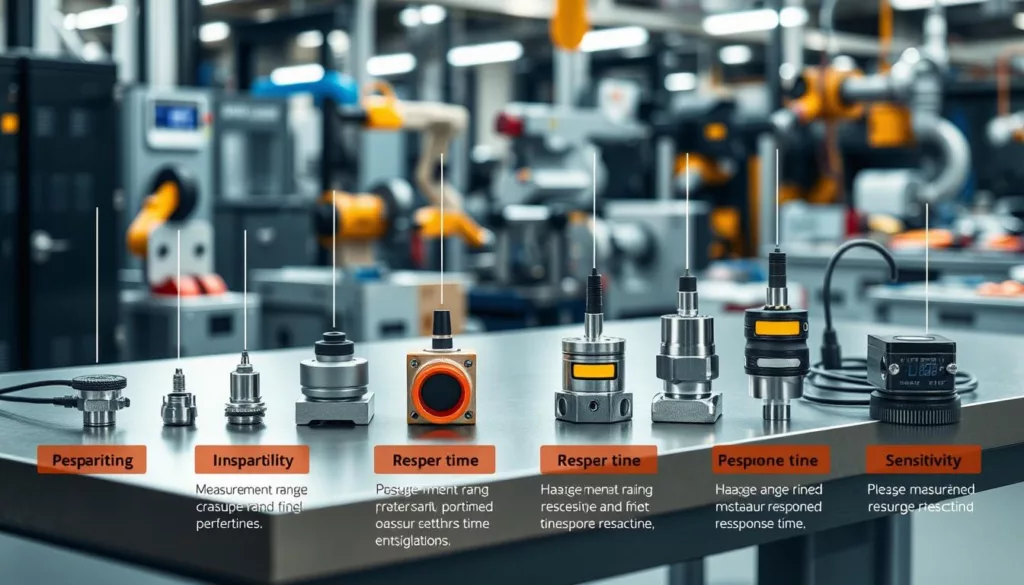In today’s competitive manufacturing world, picking the Select Right Force Sensor is key to success. This guide is here to help industrial pros find the best force sensors for their needs. We’ll explore various force sensors and how they fit into different manufacturing tasks. This way, we can work with suppliers to find the best solutions and improve production.
Key Takeaways
- Understanding different force sensor types is essential for effective selection.
- Key specifications such as accuracy and temperature range should be evaluated.
- Identifying specific manufacturing needs aids in pinpointing suitable sensors.
- Both wired and wireless options have distinct advantages based on application.
- Regular maintenance is key for the long-term success of the chosen sensors.
- Using technical resources helps make better choices.
Understanding Force Sensors in Manufacturing
Force sensors are key in many manufacturing tasks. They help measure force or load with great precision. This data is vital for making smart decisions. Knowing what a force sensor is and its types is essential for choosing the right tool for the job.
What is a Force Sensor?
A force sensor is a device that detects and measures force or load. It’s reliable, giving accurate data to boost efficiency. In assembly lines or robotics, understanding force sensors is key to keeping quality and safety high.
Types of Force Sensors Used in Industry
There are many types of force sensors for different needs in industry. The main types are:
- Strain Gauge Sensors: These measure deformation and are great for precise work.
- Piezoelectric Sensors: They handle dynamic loading well, capturing fast force changes.
- Load Cells: Used for weighing, they turn force into an electrical signal for exact readings.
Choosing the right one depends on the needed features and how it fits with the manufacturing process. Companies can find top-notch force sensors from XJCSENSOR, made for their specific needs.
| Type of Force Sensor | Measurement Principle | Typical Applications |
|---|---|---|
| Strain Gauge Sensor | Measures strain via electrical resistance changes | Precision measurement tasks |
| Piezoelectric Sensor | Generates voltage under mechanical stress | Dynamic loading measurements |
| Load Cell | Converts force into electrical signal | Weighing and load monitoring |
Key Specifications of Force Sensors
The success of a force sensor depends on its specs. We’ll look at key factors like accuracy, sensitivity, and environmental resistance. Knowing these helps pick the right sensor for your needs.
Accuracy and Sensitivity
Accuracy and sensitivity are key. A good sensor gives precise readings for quality and efficiency. High sensitivity means it can spot small force changes.
This is important in places like aerospace and medical fields. Even small errors can cause big problems.
Measurement Range
The range a sensor can measure is critical. Picking the right range is essential for good performance. A sensor out of range might not work right or give wrong readings.
Choosing the right range ensures reliable data. This is key in fields like industrial automation and robotics, where forces vary a lot.
Temperature Range and Environmental Resistance
Temperature and environmental resistance are also key. A sensor should work well in extreme temperatures. It also needs to withstand dust, moisture, and chemicals.
This keeps the sensor working well in tough conditions. It’s important for consistent performance in harsh environments.
Working with a trusted maker like XJCSENSOR is wise. They offer customizable, high-quality sensors for various needs.
| Specification | Description |
|---|---|
| Accuracy | Precision in measurements, critical for quality control. |
| Sensitivity | The ability to detect small variations in force. |
| Measurement Range | Defines the minimum and maximum forces measurable. |
| Temperature Range | The operational temperature extremes for reliable performance. |
| Environmental Resistance | Resistance to dust, moisture, and chemicals for durability. |
How to Select the Right Force Sensor for Manufacturing
Choosing the right force sensor for manufacturing starts with knowing what you need. You must assess your operational conditions and desired outcomes. Also, think about how the sensor will fit into your current workflows.
Getting accurate measurements is key. Consider the load, how often you’ll need data, and the environment. These factors can greatly affect the sensor’s performance.
Identifying Specific Manufacturing Needs
When identifying your needs, look at a few important factors:
- Operational conditions: Things like temperature, humidity, and contaminants can affect how well a sensor works.
- Real-time data requirements: Decide if you need data right away. This can help choose the right sensor.
- Load specifications: Different jobs need sensors that can handle different loads and resolutions.
Evaluating Sensor Compatibility with Equipment
It’s vital to check if the sensor will work with your equipment. Poor compatibility can cause issues and wrong readings. Here are some things to consider:
- Interface and connection standards: Make sure the sensor can talk to your systems.
- Size and mounting options: The sensor must fit and be easy to install on your equipment.
- Data output formats: The sensor’s data must be something your systems can use.
| Characteristics | Importance |
|---|---|
| Operational Conditions | Ensures sensor can function correctly in the intended environment. |
| Real-time Data | Facilitates immediate decision-making and enhances efficiency. |
| Load Specifications | Affects the accuracy and reliability of sensor measurements. |
| Interface Standards | Critical for seamless integration within existing systems. |
Comparing Force Sensor Features
Choosing the right force sensor is key. It’s important to know the differences between wired and wireless sensors. Also, understanding calibration needs is vital for accurate measurements.
Wired vs. Wireless Sensors
Wired sensors are great for stable communication and high precision. They’re perfect for places where data must be exact. Wireless sensors, on the other hand, are flexible and easy to move around. The choice depends on several factors like:
- Installation location
- Range of movement required
- Signal interference considerations
- Cost of deployment
Calibration Requirements
Calibration is critical for reliable measurements. It ensures the sensor works well under different conditions. Regular calibration helps in:
- Consistent measurement accuracy
- Extended sensor lifespan
- Improved operational efficiency
For more on load sensors and their uses, check this resource. Knowing the differences helps make the right choice for your needs.
Force Sensor Selection for Different Applications
In the manufacturing sector, picking the right force sensor is key for many tasks. The correct sensor boosts efficiency and reliability. We’ll look at three main areas where force sensors are essential: assembly line monitoring, quality control testing, and robotics automation.
Assembly Line Monitoring
For assembly line monitoring, choosing the right force sensors is vital. They provide real-time feedback, helping to fine-tune production. This ensures the assembly line runs smoothly, cutting down on downtime and boosting productivity.
Quality Control and Testing
Quality control testing greatly benefits from precise force measurements. Force sensors in quality control systems help spot defects or deviations early on. This approach improves product consistency, protecting against quality issues and keeping customers happy.
Robotics and Automation
In robotics automation, force sensors are critical for load measurement. They let robotic systems adjust to changing forces in real time. This boosts precision in tasks like assembly or material handling, leading to better overall performance.
| Application | Benefits of Force Sensors | Key Considerations |
|---|---|---|
| Assembly Line Monitoring | Real-time feedback; optimizes production | Sensor placement; response time |
| Quality Control Testing | Improved product consistency; defect detection | Calibration; integration with existing systems |
| Robotics Automation | Enhanced precision; load measurement | Compatibility with robotic systems; safety protocols |
Best Practices for Choosing the Best Force Sensor
Choosing the right force sensor is key to performance and reliability. It’s important to stay updated with the latest information. Consulting technical resources gives us insights into new advancements and standards.
Consulting Technical Resources
Technical resources are a treasure trove of knowledge. Manufacturers share detailed specs and application notes. Research papers, online databases, and industry publications also offer valuable insights into new technologies and trends.
- Review technical datasheets for specific performance metrics.
- Examine case studies for practical applications and results.
- Participate in webinars and training sessions for expert guidance.
Engaging with Suppliers and Manufacturers
Talking to suppliers is essential. It helps us understand their products better. We can discuss our needs and get advice on what works best for us.
- Schedule meetings to discuss product offerings and industry needs.
- Request samples to evaluate performance in real-world settings.
- Ask for recommendations based on specific operational requirements.
By following these steps, we can make better choices. This ensures our decisions meet our manufacturing goals and project needs.
Force Sensor Application Tips
Using force sensors in manufacturing needs careful setup and data review. The right placement and setup are key for accurate readings. Here are some tips to get the best from your force sensors.
Installation Best Practices
For accurate force sensor use, follow these steps:
- Choose a stable mounting surface to reduce vibration and interference.
- Align the sensor correctly with the load path for precise measurements.
- Use the right fasteners to keep the sensor steady, avoiding movement during use.
- Consider the environment, including temperature and humidity, for better performance.
Data Interpretation and Analysis
Understanding your data is vital for using force sensor outputs well. Here are tips for better analysis:
- Use software that shows data in real-time.
- Set baseline measurements to spot any unusual changes.
- Apply statistical methods to see trends over time, helping in making decisions.
- Train your team to read data well for better insights.
Common Mistakes in Force Sensor Selection
Choosing the right force sensor is key. But, many people make mistakes that can hurt performance. One big error is ignoring environmental factors.
Sensors work in many different conditions. Things like humidity, temperature changes, and chemicals can affect how well they work. If you don’t think about these before you install, your sensor might not work right or could fail.
Overlooking Environmental Factors
It’s important to know how the environment affects sensors. For example, sensors in places with a lot of humidity or very hot or cold temperatures might need special materials or protection. If you don’t consider these things when you choose a sensor, you might have to do more maintenance. This can cause delays and hurt how well things get made.
Ignoring Maintenance Requirements
Another mistake is not thinking about how much maintenance a sensor needs. All sensors need to be checked and kept up to work well and last a long time. People often think that once a sensor is installed, it will just keep working forever.
But, regular maintenance is key. It helps find problems early, so you can fix them before they cause big issues. This keeps things running smoothly and helps you make more.





